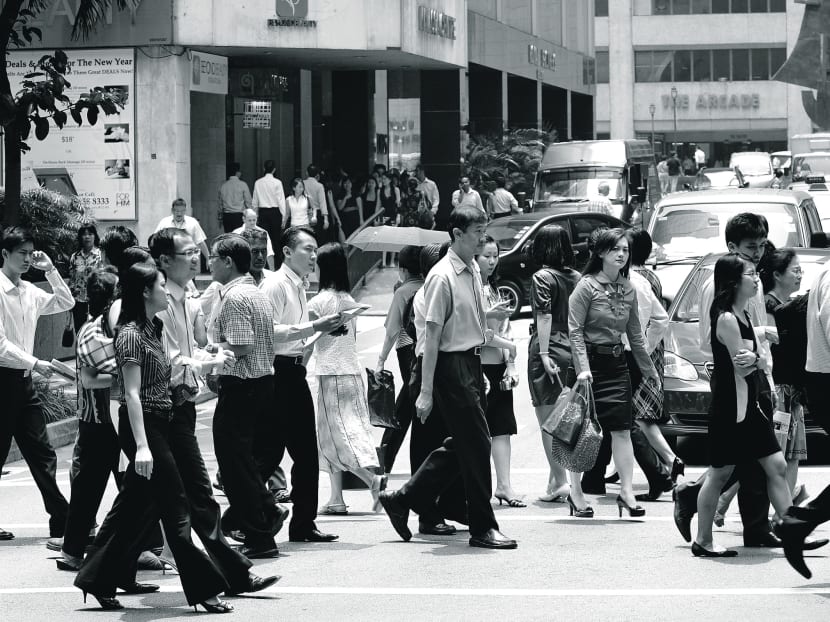Economic opportunities in an ageing population
From the perspective of economic policy, the ageing population in Singapore poses significant challenges.

In the next 10 years, the more affluent retirees from the baby boomer generation will likely provide demand for a wide range of goods and services commensurate with their improved standard of living. Photo: Bloomberg
From the perspective of economic policy, the ageing population in Singapore poses significant challenges.
The old-age support ratio — which measures the ratio of residents aged 20 to 64 to those aged 65 years and over — has trended downwards from 13.5 in 1970 to 6.7 last year. As fewer people are working and paying taxes, the Government would have to look for alternative sources of revenue to fund the public expenditure on healthcare, particularly as it has signalled that the State’s share of healthcare bills will increase.
At the same time, the Government will have to set aside a larger slice of the fiscal budget to subsidise the poor and needy among the growing numbers of seniors. Increased expenditure might require taxes to be raised, which could undermine the incentive to work and invest in the economy.
But while the economic challenges are significant, the ageing population offers a myriad of opportunities for businesses. Take Sweden for example, where total healthcare expenditure accounts for nearly a tenth of gross domestic product.
The Swedish healthcare industry is largely driven by the needs of its elderly and ageing population. Pharmaceuticals and medical services markets are anticipated to expand steadily over the next five to 10 years.
While Scandinavian countries such as Sweden have strong pension systems providing support for citizens’ rising healthcare needs, in Singapore, rising affluence and the improving educational profile suggest also higher consumer expectations among the ageing population.
Data from the Census of Population indicates that the median household income has increased at an average rate of 3.2 per cent per annum over 2000 to 2010. More households have also been upgrading their housing over the last decade as the proportion of those staying in condominiums and private flats increased from 6.3 per cent in 2000 to 11 per cent in 2010, representing a larger source of monetisable assets.
Over the next five to 10 years, the more affluent retirees from the baby boomer generation will likely provide demand for a wide range of goods and services commensurate with their improved standard of living. Such demand in the silver economy ranges from pharmaceutical products and private healthcare services, to apparel and footwear tailored to the needs of seniors.
Moreover, the higher educational profiles of the retirees from the baby boom generation also means that they are likely to demand a comprehensive range of financial and insurance services (above and beyond the new MediShield Life) which would meet their individual needs in wealth management.
SHOPPING CARTS WITH MAGNIFYING GLASSES
How have companies benefited from the growth of the silver economy in countries with ageing populations? Take the case of Japan, which has more than 30 million people who are aged 65 and above.
Many companies in Japan are taking advantage of the rising market opportunities generated by the seniors. The NTT DoCoMo company, the country’s largest wireless carrier, has launched a smartphone targeting older customers who need larger fonts and more simplified steps for sending emails and taking pictures.
The retailer Aeon runs a supermarket that has a medical centre and provides shopping carts with magnifying glasses for seniors. Even the travel industry in Japan is benefiting from increased travel expenditure by the country’s rising number of retirees in the population.
Notwithstanding the demand from more affluent retirees in Singapore who would provide support for the silver economy ranging from healthcare and apparel to financial and tourism services, there are two critical factors which might restrict the spending power of the silver consumer and slow the growth of the silver economy in the near term.
First, in contrast to the more affluent seniors, there is a group of Singaporeans who are “falling through the cracks” in government support provided for the poor and underprivileged. As the spending power of this group of retirees is likely to be limited when they retire, they might not provide as much stimulus to the expansion of the silver economy as Singapore’s population ages.
Second, unlike Japan which has a large pool of seniors numbering more than 30 million, the development of the silver economy in Singapore, with fewer than one million seniors, would take some time before firms can enjoy economies of scale in mass production for the silver market.
Thus, on the supply side, the lack of short-term cost competitiveness in large scale production for the silver economy could limit its growth in the near term.
Even so, while the growth of the silver economy would take time for firms to realise its full potential, companies which are positioned to identify the specific niches of demand for targeted groups of retirees will stand to gain as the demographic trends evolve over time.
ABOUT THE AUTHOR:
Dr Seet Min Kok is a senior lecturer at SIM Global Education. He is also a Council Member with the Economic Society of Singapore.






